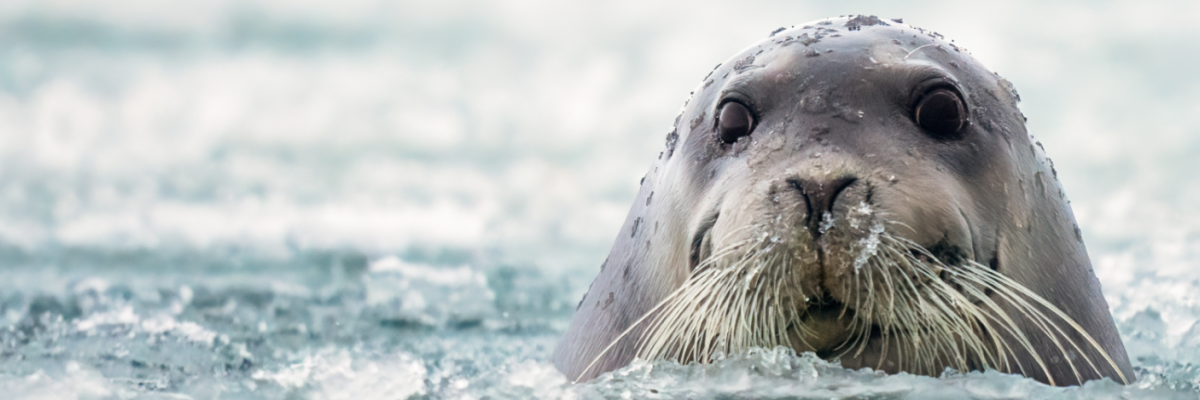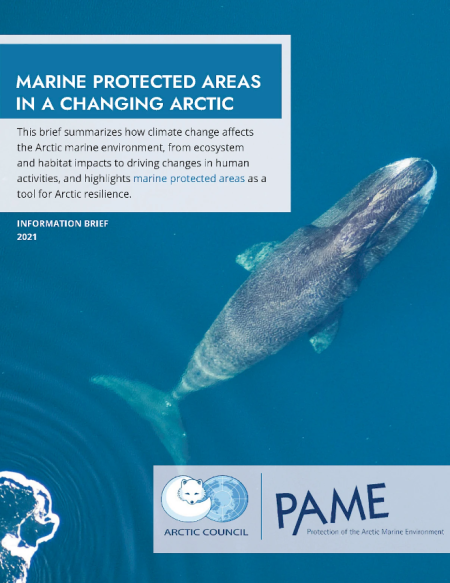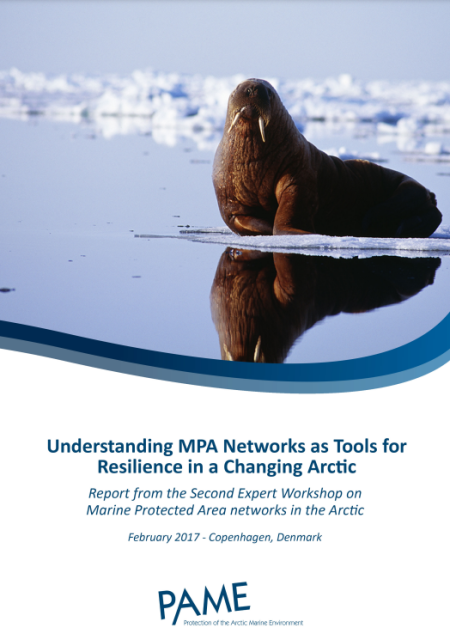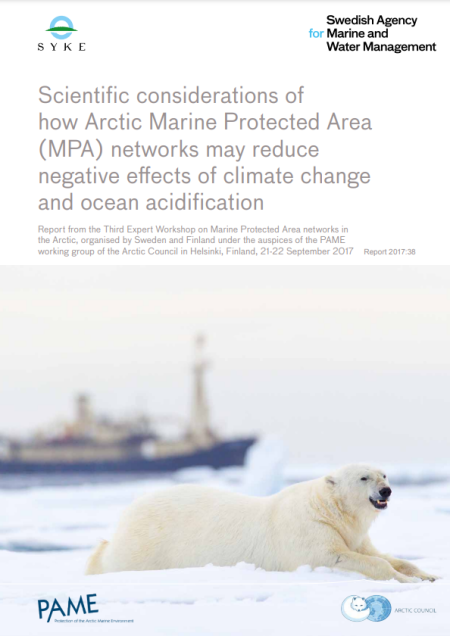
MPA's and Climate Change
 In 2021, PAME approved the "Marine Protected Areas in a Changing Arctic" Information Brief. It summarizes how climate change affects the Arctic marine environment, from ecosystem and habitat impacts to driving changes in human activities, and highlights marine protected areas as a tool for Arctic resilience.
In 2021, PAME approved the "Marine Protected Areas in a Changing Arctic" Information Brief. It summarizes how climate change affects the Arctic marine environment, from ecosystem and habitat impacts to driving changes in human activities, and highlights marine protected areas as a tool for Arctic resilience.
Marine Protected Areas as a Conservation Tool
Marine protected areas (MPAs) are a proven tool for conserving species, habitats and ecosystems, and provide social and economic benefits to Arctic communities. Under the Convention for Biological Diversity (CBD), Aichi Target 11 called for the protection of 10% of coastal and ocean waters by 2020, with a focus on areas of particular importance for biodiversity and ecosystem services. In 2016, 4.7% of marine waters in the Arctic and 7.4% globally were protected.
The CBD is now establishing a post-2020 Global Biodiversity Framework, which will set global conservation goals for the coming decades. Many scientists have stated that the 10% goal for marine protection is insufficient to sustain a healthy ocean and the ecosystem services it provides, and have called for broader protection goals of 30% or more through MPA networks that represent and connect diverse ecosystems.
The CBD and International Union for the Conservation of Nature also recognized that well-managed areas that are not MPAs can contribute to conservation outcomes, and that these “other effective conservation measures (OECMs)” can be an important component of MPA networks. The recognition of OECMs provides the opportunity to promote additional partnerships in global conservation.
Arctic MPAs are diverse in their objectives, locations and scale, extending from coastal and estuarine waters to deep sea canyons, and in some cases designed for social and cultural outcomes as well as conservation. Biodiversity benefits are closely linked to levels of protection, with higher levels of protection providing the greatest scope for ecosystem resilience and recovery.
However, given the scale and pace of global climate change impacts and biodiversity loss, MPAs are only part of the solution for a healthy ocean, and can be complemented by other measures to manage human activities (e.g., fisheries management, pollution management). With new species arriving in Arctic waters, and ice-dependent species concentrated in shrinking ice areas, scientists and managers have also identified a growing need for dynamic place-based measures that can manage species in rapidly changing conditions.
 Understanding MPA Networks as Tools for Resilience in a Changing Arctic
Understanding MPA Networks as Tools for Resilience in a Changing Arctic
PAME convened a workshop in February 2017 on approaches for understanding and managing spatial variability of ecological connectivity affected by anticipated climate change, as well as how MPA networks can help build resilience to climate change.
The purpose of the workshop was to “support a PAME project studying best practices for linking area-based conservation measures to categories of Arctic marine biodiversity in support of the long-term onservation of the Arctic marine environment and associated services and cultural values.”
The workshop objectives were:
- Develop our understanding of ecological resilience, and of how MPA networks can help support such resilience.
- Develop principles to guide management of MPAs and MPA networks to enhance ecological resilience in a changing environment.
- Develop our understanding of key elements needed to design MPA networks that support ecological resilience in a changing environment.
- Identify priorities for future scientific and/or other collaboration to apply knowledge and guidance to MPA network design.
- Identify potential next steps to advance the understanding of how MPA network design and management can support ecological resilience to a changing environment.
In addition to presentations on a range of topics of relevance to the workshop objectives, and ensuing discussions and Q&A sessions, the workshop included:
- a continuation of discussions from the first workshop (held in September 2016) on the role and function of particular species that highlight the importance of ecological connectivity in the Arctic marine environment,
- discussions on how ecological connectivity can vary and be affected by anticipated climate change,
- Discussions on how MPA networks can help build ecosystem resilience to climate change;
- presentations and discussions on the role and importance of various design elements when developing MPA networks in the Arctic under a changing climate; and
- the development of additional guidance that will be used to expand and refine the “MPA Toolkit” which can be used my PAME members when planning or designing new protected areas in the Arctic.
 Scientific Considerations of how Arctic Marine Protected Area (MPA) networks may reduce negative effects of climate change and ocean acidification.
Scientific Considerations of how Arctic Marine Protected Area (MPA) networks may reduce negative effects of climate change and ocean acidification.
A 2017 PAME workshop aimed to take stock of the current scientific understanding (including TLK) and identify important new research questions on MPA networks and how such networks, and other area-based measures, may be used to decrease the negative effects ofclimate change and ocean acidification and their interactions with other human induced stressors in the Arctic. The workshop also briefly touched on data availability related to these questions.
During this third expert workshop the scientific basis of how MPA networks may reduce negative effects of climate change and ocean acidification in the Arctic region was discussed. Workshop participants were mainly scientists with expertise on Arctic marine ecosystems, climate change, ocean acidification and/or MPAs. The intention of the workshop was not to reach consensus and provide a fixed list of ecommendations, but rather to summarize:
- the best available knowledge that can already be applied to the planning of a pan-Arctic MPA network, and
- the primary uncertainties and, hence, what necessary scientific knowledge is still lacking.
As such, the six main outcomes from the workshop below contribute to the scientific basis for the potential of MPAs as a tool to meet the threats posed by climate change and ocean acidification to Arctic ecosystems and livelihoods.
The six main outcomes were:
- A paradigm shift for establishing MPAs is necessary
- Existing MPA criteria need to be adapted to Arctic conditions
- Arctic MPAs should be located in areas that are expected to become refugia
- Additional stresses should be targeted
- The scientific knowledge basis must be improved
- Identification of research priorities
 Arctic Council Working Group
Arctic Council Working Group